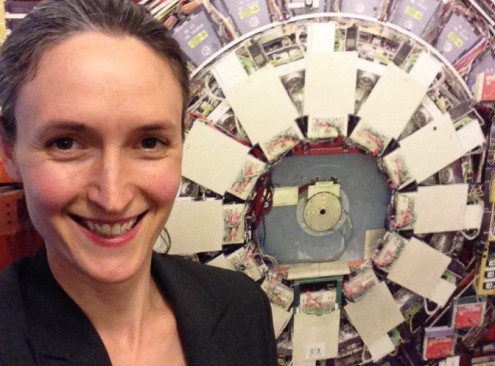© Pint of Science, 2025. All rights reserved.
From the elusive Higgs boson to the vast reaches of the cosmos, our universe holds deep mysteries. Discover how particle physics challenges the Standard Model, explore black holes, dark matter, and hidden dimensions, and uncover how starquakes let us peer inside stars. These talks take us to the frontiers of discovery, where the smallest and largest scales collide.
The speed limit of the Universe
Sarah Demers
(Professor )
One of the oddest things we have learned about the universe is that it has a speed limit. We haven't found anything that travels faster than the speed of light. And interestingly, we also see that particles with mass can't get to the speed of light no matter how hard we push them. From the particle physics perspective, before the Higgs boson was discovered the mystery was actually, "Why isn't everything zipping around at the speed of light? What slows things down?" I'll give a bit of history of the Higgs boson discovery and talk about our current understanding of what mass is.

An Odyssey through our Universe from the Big Bang to Black Holes, Unknown Dark Forces, and Unseen Dimensions and Universes
John Harris
(Professor Emeritus)
A pedestrian’s guided tour through our Universe - from the Big Bang to a hot quark soup into the regime of particles, atoms and molecules, followed by galaxies, solar systems, planets and colliding black holes. Gravity governs falling objects and planetary motion and creates black holes. Quantum Mechanics describes the world of particles and atoms. Quantum Mechanics and Gravity are in a conflict of cosmic proportions that must be resolved! String Theory purports to explain everything, but it requires unseen dimensions of space and time. Meanwhile, other conflicts are brewing, like unseen Dark Matter and invisible Dark Energy. Where do we go from here? Are there extra dimensions and unseen universes?

How can you look inside a star?
Earl Bellinger
(Professor)
Stars are not merely points of light; rather, they have a physical size and internal structure. At first glance, it might seem impossible to peel away a star's outer layers to look inside. However, over the last two decades, the amazing science of asteroseismology has emerged, enabling us to peer into the hearts of stars and measure their interiors. Just as earthquakes reveal the structure of the Earth, starquakes reveal the structure of stars, including that of our own Sun. This, in turn, allows us to test our understanding of stellar evolution and fundamental physics alike, ultimately shedding light on our place in the cosmos.

Map data © OpenStreetMap contributors.